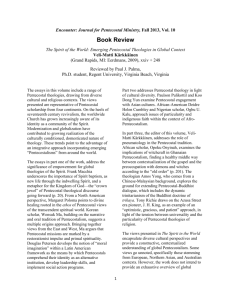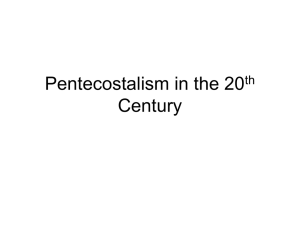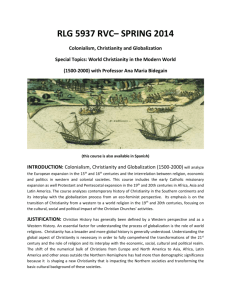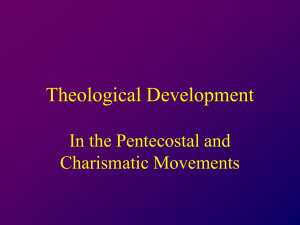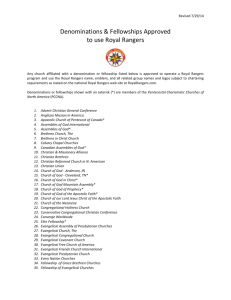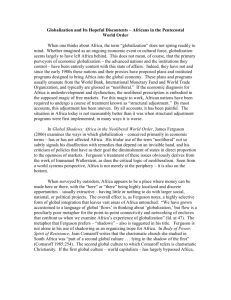Klaus__Growing Edges have Shifted
advertisement
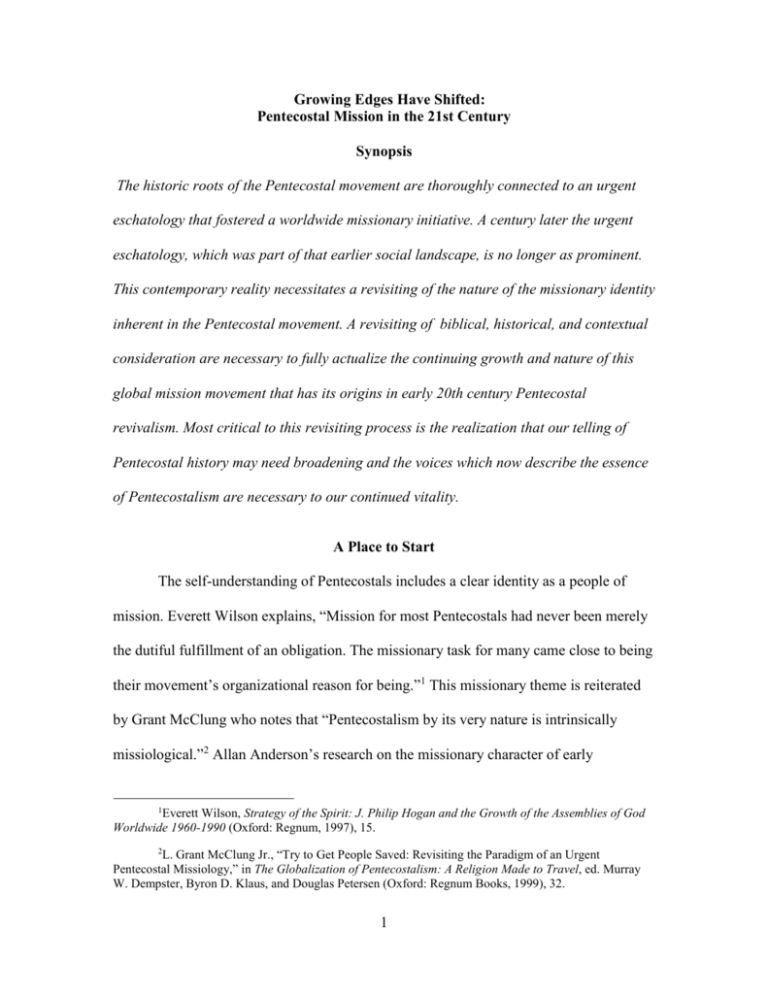
Growing Edges Have Shifted: Pentecostal Mission in the 21st Century Synopsis The historic roots of the Pentecostal movement are thoroughly connected to an urgent eschatology that fostered a worldwide missionary initiative. A century later the urgent eschatology, which was part of that earlier social landscape, is no longer as prominent. This contemporary reality necessitates a revisiting of the nature of the missionary identity inherent in the Pentecostal movement. A revisiting of biblical, historical, and contextual consideration are necessary to fully actualize the continuing growth and nature of this global mission movement that has its origins in early 20th century Pentecostal revivalism. Most critical to this revisiting process is the realization that our telling of Pentecostal history may need broadening and the voices which now describe the essence of Pentecostalism are necessary to our continued vitality. A Place to Start The self-understanding of Pentecostals includes a clear identity as a people of mission. Everett Wilson explains, “Mission for most Pentecostals had never been merely the dutiful fulfillment of an obligation. The missionary task for many came close to being their movement’s organizational reason for being.”1 This missionary theme is reiterated by Grant McClung who notes that “Pentecostalism by its very nature is intrinsically missiological.”2 Allan Anderson’s research on the missionary character of early 1 Everett Wilson, Strategy of the Spirit: J. Philip Hogan and the Growth of the Assemblies of God Worldwide 1960-1990 (Oxford: Regnum, 1997), 15. L. Grant McClung Jr., “Try to Get People Saved: Revisiting the Paradigm of an Urgent Pentecostal Missiology,” in The Globalization of Pentecostalism: A Religion Made to Travel, ed. Murray W. Dempster, Byron D. Klaus, and Douglas Petersen (Oxford: Regnum Books, 1999), 32. 2 1 2 Pentecostalism chronicles the very human nature of the participants in this incipient era, describes their stories “warts and all.” While the clay feet of these early pioneers are selfevident, Anderson’s conclusions reinforce the understanding of early Pentecostalism’s essential missionary nature. He posits that Pentecostalism has always been a missionary movement in foundation and essence. Its firm conviction was that the Spirit had been poured out in “signs and wonders” in order for nations of the world to be reached for Christ before the end of the age.3 Arguably, the single most enduring contribution the late Pentecostal historian Gary McGee made to the understanding of the Pentecostalism as a missionary movement was his description of the “radical strategy” that typified early Pentecostal mission. While acknowledging a missiological perspective shared in varying degrees by a broad set of Christian tradition, he highlighted the emergence and significance of this radical strategy as a critique of the Great Century of missions represented in the 19th century. This radical strategy was a uniquely pneumatological approach to mission that affirmed a belief in the need for a subsequent spiritual empowerment that sent the recipient toward a destiny connected to the continuing redemptive mission of Jesus Christ. The empowerment was for the purpose of world evangelism and the soon return of Christ made it necessary to “work while it is day” (John 9:4). This work, empowered by the Holy Spirit, was accompanied by signs and wonders, thus energizing missionary efforts and hastening the return of Christ. While some might argue that Pentecostals have historically been more “doers” than thinkers and/or theologians, McGee’s description of the radical strategy provides an 3 Allan Anderson, Spreading Fire: The Missionary Nature of Early Pentecostalism (Maryknoll: Orbis Books, 2007), 294. 3 alternative view to such conventional wisdom. The missiological quandary that was felt by missionary efforts in the late 19th century was how their efforts could be accomplished more rapidly and effectively. The growing passion among this deeply committed cadre of mission-minded people (typified in the Student Volunteer Movement) was to seek the restoration of the Spirit’s power as taught and illustrated in the New Testament. The DNA of Pentecostalism, personified in the radical strategy, was the clear mark of a fresh theological reflection and strategic critique offered by these early pioneers as an intentional response to the missionary quandary of “how to reach the world in this generation.”4 It would not be an overstatement to describe incipient Pentecostalism as both strategically pro-active and theologically aware. An Alternative Historiography There have been a growing number of scholars who have questioned a historiography that tips the scales of an understanding of Pentecostalism, toward an exclusively missionary lens.5 The proponents of the growing alternative historiographical lens are increasingly arguing that any view of global Pentecostals that promotes homogeneity and diminishes the agency of local actors in the story must be critiqued. This alternative perspective posits that the global imagery should be understood to refer Gary McGee, “The Radical Strategy in Modern Mission: The Linkage of Paranormal Phenomena with Evangelism,” in The Holy Spirit and Mission Dynamics, ed. C. Douglas McConnell (Pasadena: William Carey Library, 1997), 69-95. See also McGee’s final volume published posthumously: Gary McGee, Miracles, Missions and American Pentecostalism, American Society of Missiology, No. XLV (Maryknoll, NY: Orbis Books, 2010). 4 5 The Azusa Street versus multiple fountainhead (global) discussion can be seen in Edith Blumhofer’s “Revisiting Azusa Street: A Centennial Retrospect” in International Bulletin of Missions Research, vol. 30, no. 2, 59-69. Allan Anderson also deals with the multiple fountainhead discussion in An Introduction to Pentecostalism: Global Charismatic Christianity (Cambridge, UK; New York : Cambridge University Press, 2004). A much earlier discussion of the multiple fountainhead perspective is seen in Karla Poewe, ed. Charismatic Christianity as a Global Culture (Columbia SC: University of South Carolina Press, 1994). 4 to represent various expressions of Pentecostalism worldwide as opposed to the seeing Pentecostalism merely through its missionary initiatives around the world. The late Ogbu Kalu has offered his analysis that studies in pneumatology may help us better name Pentecostalism because, in so doing, the different roots of these movements, in various places globally, compelled believers to name the movement differently. Kalu insists on a description of global Pentecostalism that takes the global diversity of Pentecostal movements with utter seriousness. He cautions Pentecostal historians, that Pentecostal historiography is better served by not always searching for founding missionaries in non-western contexts. He also posits that the American connection to Pentecostals globally is best studied through focusing on the character of a local Pentecostal movement rather than on its origins. Kalu’s approach argues for a Pentecostal historiography that differs from a missionary historiography; one that represents a culturally “insider” understanding of the sovereign movement of the Holy Spirit worldwide.6 On the one hand, Kalu’s observations can be construed to reflect a perspective indicative of the residue from a long and painful shadows cast by a colonial era. However, this emerging historical perspective also speaks powerfully of the intent of the Spirit that “bloweth where it listeth’ and the empowerment of the Spirit at Pentecost to bear witness to the nations. Why would we be surprised that a Redeemer God would graciously move on a plethora of “nations” globally that seemingly have no connection to Ogbu Kalu, “Modeling the Genealogy and Character of Global Pentecostalism: An African Perspective” (lecture, Society for Pentecostal Studies, Fuller Theological Seminary, Pasadena, CA, 2006). See other works by Kalu including, African Pentecostalism: An Introduction (Oxford: Oxford University Press, 2008); Ogbu Kalu, ed. Interpreting Contemporary Christianity: Global Processes and Local Identities (Grand Rapids: Eerdmans, 2008). Kalu’s suggestions are given high praise in Mark Noll, The New Shape of World Christianity: (Downers Grove: IVP Academic, 2010) 121-125. Amos Yong is most prolific in his emphasis on pneumatology as a common lens for understanding a truly global Pentecostal theology. For example, see Amos Yong, The Spirit Poured Out on All Flesh: Pentecostalism and the Possibility of Global Theology (Grand Rapids: Baker Academic, 2005). 6 5 the “established center”? It very well may be that the growth of Pentecostals globally most faithfully reflects the prophetic utterance in Isaiah 65 that God would actually reveal Himself to those that did not ask for Him and be found by those who did not seek Him. Might we look forward to a day when a Pentecostal historiography represented by Kalu and a missionary historiography, that historic mission sending agencies are more familiar with, could together express gratefulness to God that we all are part of an eschatological destiny initiated by a redemptive God and empowered by the Holy Spirit? Shifts in the Contextual Center As we enter, what some would call, the second Pentecostal century, the urgent eschatology of the century past is less obvious. Won Suk Ma has observed that the eschatological expectations present in Western Pentecostals are not quite as evident in Asian Pentecostal churches. He notes that a “this world” message is much more obvious than an “other-worldly” message. The question is now arising as to whether or not this growing reliance on the “this-worldly” empowerment may actually disconnect Pentecostals from the “eternal dimensions” of their urgent eschatological rooting.7 The unique historical context in which Pentecostalism emerged leads to a particular understanding of what constitutes mission. As previously noted, the “radical strategy” was a clear critique of the evangelization by civilization strategy central to the 19th century missionary efforts from the West. There is no doubt that the kerygmatic/proclamation/ church planting focus, favored by early Pentecostals, clearly reflected their urgent eschatology and resulting strategic priority. This priority is clearly 7 Won Suk Ma, “Asian Pentecostal Theology,” in Asian Journal of Pentecostal Studies, vol. 1, no. 1 (January 1998): 28. 6 seen in the writing of proto-missiologist Alice Luce, who summarized mission strategy of the day when she said, “When we go forth to preach the Full Gospel, are we going to accept an experience like that of denominational missionaries or shall we look for signs to follow?” 8 Simply put, the success of the expansion of the gospel connected to the first century of Pentecostal efforts requires critique exactly because of the explosive growth of the movement. The movement’s growth is so obvious in the majority world that a new set of contextual factors are becoming, or necessity, part of Pentecostal theological reflection. The realities of poverty, injustice, and violence will certainly require fresh and critical theologizing on the nature of Pentecostal mission. Gordon Fee’s life-long championing of the biblical theme of the Kingdom of God will find a more exhaustive understanding as Majority World Pentecostals bring a fresh understanding of the diakonic and koinonaic dimensions of Kingdom life that are perpetuated in the planting of local churches globally.9 The tension-filled terrain of gospel and culture will most likely see followers of Jesus, in contexts of violence and injustice, read the book of Acts and identify with their brothers and sisters of the Early Church. This contemporary vanguard of Spirit empowered believers will obediently follow Jesus, being empowered by the Spirit, while oblivious to the price of trusting God in a faith-filled way. If it is true that Christianity’s center is now in the Southern Hemisphere, a refined understanding of the identity of Pentecostal mission certainly needs to acknowledge the 8 Everett Wilson and Ruth Marshall Wilson, “Alice Luce: A Visionary Victorian,” in Portraits of a Generation: Early Pentecostal Leaders, ed. James R. Goff, Jr. and Grant Wacker (Fayetteville: University of Arkansas Press, 2002), 159-176. Gordon Fee, “The Kingdom of God and the Church’s Global Mission,” in Called and Empowered: Global Mission in Pentecostal Perspective, ed. Murray Dempster, Byron D. Klaus, Douglas Petersen (Peabody: Hendrickson, 1991), 7-21. 9 7 insights and theological reflection of this burgeoning center of influence. Indicative of the maturity of this new global synergy is found in Veli-Matti Karkkainen’s publishing of Spirit in the World: Emerging Pentecostal Theologies in Global Contexts.10 What is clear is that well-trained scholars and church leaders are in place to speak prophetically to the historic sending Church in the North. Representative of this growing majority world voice is Indian Pentecostal, Ivan Satyavrata, who served as the 2009-2010 J. Philip Hogan Professor of World Mission at the Assemblies of God Theological Seminary. He delivered a set of lectures that provide a significant voice demonstrating the keen awareness that exists in the Majority World as to the place we find ourselves as we enter the second decade of the 21st century. These lectures moved beyond the expected discussions of the indigenous church, contextualization, and even mission partnership. All of these themes are necessary dimensions of missiological understanding, but Satyavrata offered new frameworks for understanding 21st century Pentecostal mission around a unique understanding of being peers and friends. Gone were the “us-them” categories of missionary and national and now present were categories more attuned to the heart of relationships and communication in our globalized world. Satyavrata’s lectures offered a sterling example of clear thinking from the new center of influence in Christianity and, in particular, Pentecostalism. He suggests that the current context of globalization and urbanization may in fact be the contemporary “fullness of time” for Pentecostal Christianity to surge in new and vital ways. He offers a 10 Veli-Matti Karkkainenn, Spirit in the World: Emerging Pentecostal Theologies in Global Context (Grand Rapids, Eerdmans, 2009), xiii-xxiv. 8 set of challenges that require specific responses by Pentecostals. Our corresponding actions will have serious impact on our identity and sense of biblical mission. Massive human migration necessitates a focus on urban centers The deterritorialization of culture requires us to radically rethink our understanding of indigenous culture, because previous understanding of culture, as a local and even geographical category, is inadequate. Culture shock and religion-quake necessitates the response to multiculturalism and religious pluralism that rethinks the nature of “the other.” The shifting center of Christianity requires us to work toward new covenants in mission endeavor that moves beyond the category of object to partner/friendship categories that have yet to be fully experienced. The rise of global poverty and resulting threat to humanity requires the development of a theology of integral mission and interdependence. Political resistance to traditional missionary activity requires pursuing creative avenues of access and a more complete theology of suffering in violent contexts The explosion of information, communication and technology requires creative new innovation that moves beyond blind acceptance of technological advancement.11 Satyavrata’s critical work is not just about discussions of the missionary and national, but global partners and friends addressing challenges that face followers of Jesus who have embraced a spirituality that implicitly values the vibrancy of a Spirit-empowered life. Ivan Satyavrata, “Following the Wind and Riding the Wave: Pursuing the Hogan Legacy into the Second Pentecostal Century,” Assemblies of God Theological Seminary, http://www.agts.edu/news/news_ archives/2009_16satyavrata_lecture.html (accessed June 20, 2010). 11 9 As the global South exerts its growing influence, a truly global Pentecostal historiography will acknowledge an obvious, though rarely studied dynamic that reinforces a Pentecostalism which is more pneumatologically flavored. The sheer breadth of global migration in the 21st century offers a lens of consideration that needs to be seen not only sociologically, but biblically. A missionary historiography usually focuses its storyline on Christianity’s movement from North to South and West to East. However, the revitalization and even reestablishment of Christianity, through the power of mass migration, is now occurring from the Majority World to the North and West. We now see Christian missionary efforts proceeding from all nations to all nations in a way that seemingly has little comparable expression in church history. Joe Castleberry’s Pentecostal reading of the missio humanitatis passage in Genesis 1:28 gives us critical traction in seeing that the current phenomenon of mass migration is not merely a result of political and socio-economic upheaval. It is quite clear that the places where Pentecostalism has taken root and grown with vitality are also among the peoples whose migration has become a necessity to survive. Rather than merely seeing this reality as a sociological phenomenon, might it not be a part of a more global Pentecostal perspective to see the foundational role of migration in a biblical theology of mission? How to be a steward of the Holy Sprit’s work in migration patterns is more reasonably seen through the lens of a global Pentecostal historiography than a missionary historiography. It is clear in Europe and increasingly obvious in Canada and the USA that a spiraling decline of local Christianity in the West may only be halted and turned around by a vital cooperation between local follower of Jesus and the vital evangelizing DNA of 10 immigrants from the Majority World. (Ironically, the West may increasingly be a place where the Isaiah 65:1 theme of God’s sovereign redemptive action expresses itself.) 12 Globalization’s Long Reach The Era of Globalization is fast becoming a preferred term for describing the current times. Just as the Cold War Era or the Space Age might be used to describe particular periods of history; globalization describes the political, economic and cultural atmosphere of today. People around the globe are more connected to each other than ever before. Information and money flow with great ease across the planet. Goods and services from one region of the world are increasingly available across the globe. International travel and, more importantly, communication is commonplace and has taken on the description of globalization. Limiting globalization to describing economics worldwide would certainly impede the long reach of this phenomenon. As with many issues in the earlier parts of the 21st century, coming up with an agreed upon definition for globalization is a challenge. However, the larger challenge is evaluating whether globalization is a good thing or actually a problem.13 Ivan Satyavrata observes that globalization is not about some new economic theory discussed in developed nations, but a new form of culture that knows no boundaries and is spread globally. It involves multi-national interconnectedness in the Joseph Castleberry, “Procreation, Migration and Dominion in Genesis 1:28 and its Missiological Importance,” (paper, Society for Pentecostal Studies, Duke University, Durham, NC, 2008). Also see a unique Chinese version of this phenomena in Paul Hattaway, Back to Jerusalem: Three Chinese Leaders Share Their Vision to Complete the Great Commission (Carlisle, UK: Piquant, Waynesboro, GA: Gabriel Resources, 2003). 12 Keith Porter, “Globalization: What is it?” About .com, www.usforeignpolicy.about.com /odtrade/a/whatisgz.htm?p=1 (accessed August 6, 2008). See also, Peter Berger, “Religion in a Globalizing World,” Pew Forum, www.pewforum.org/events/?EventID=136 (accessed September 5, 2008). 13 11 transfer of ideas and products and includes the trans-national corporations and western governments that ride the economic globalization wave; as well as the global anticapitalism movements that oppose it. Satyavrata says that when ideas get to their new destination they are not imbibed as they are; rather, they are adapted to fit the local situation. This interaction between global and local is sometimes referred to as glocalization. Thus, rather than eliminating cultural differences, globalization includes localization as an essential feature.14 In a very real sense, postmodernism and globalization are linked together. Western discussions of post-modern theory tend to reframe it for the safe domain of epistemology, when a more realistic understanding sees it as synonymous with the flattening of the world by globalization. This movement, by any description, is a global movement. The “globopomo” turn is not about whether we will offer fair-trade coffee at our image-driven worship event aimed at the “creative” class of slick urbanites. It is not merely the domain of the educated “chattering class” adept at the intricacies of continental philosophy. It is a broader theme, with global conflicts like the world of mass migration, persistent genocides, increased gaps in global wealth distribution and the growth of global Islam.15 In the era of globalization (however it is described and defined), Christianity has been growing vigorously. Fifteen years ago, Harvey Cox predicted the shape of Pentecostal spirituality fit the twenty-first century. He foresaw that this “religion made to 14 Ivan Satyavrata, (lecture, Oxford World Missions Briefing, sponsored by the Oxford Centre for Mission Studies in Oxford, England, May 2004). 15 Carl Raschke, GloboChrist: The Great Commission Takes a Post-modern Turn (Grand Rapids: Baker Academics, 2008), 12. 12 travel” would contextualize itself globally and be the primary texture of Christianity in this century16 Sociologists like David Martin and David Stoll began applying new lenses to the massive Pentecostal growth in Latin America asking such unthinkable questions as: “Is Latin America turning Protestant?”17 Liberation theologians adjusted their interpretive lenses and even dared to see Pentecostals as the future of the Christian Church.18 Philip Jenkins has confirmed what evangelical missiologists had been saying for years, namely, Christianity has a new center and it is geographically in the Southern Hemisphere. Jenkins goes so far as to say that Pentecostals might be the most successful social movement of the twentieth century. We are only beginning to understand the significance of a single century of Pentecostal history on this planet.19 This significant growth and its global occurrence requires reflection on how the current context, replete with globalized realities, affects the fabric of Pentecost worldwide. While acknowledging the particularity of local “Pentecostalisms”20 and avoiding the temptation to generalize about Pentecostals based on personal experience, we must acknowledge that the historical holiness DNA of many Pentecostals has left us 16 Harvey Cox, Fire From Heaven: The Rise of Pentecostal Spirituality and the Reshaping of Religion in the Twenty-first Century Reading: MA: Addison Wesley, 1995). 17 David Stoll, Is Latin America Turning Protestant? (Los Angeles: University of California Press, 1990); David Martin, Tongues of Fire: The Explosion of Protestantism in Latin America (Oxford, UK: Basil Blackwell, 1990). 18 Richard Shaull and Waldo Cesar, Pentecostalism and the Future of the Christian Churches (Grand Rapids: Eerdmans, 2000). 19 Philip Jenkins, The Next Christendom: The Coming of Global Christianity (New York: Oxford University Press, 2007), 8. Also, see Philip Jenkins, “Reading the Bible in the Global South,” International Bulletin of Missionary Research 30, no. 2 (April 2006), 67-73. Jose Miguez Bonino, “Changing Paradigms: A Response,” in The Globalization of Pentecostalism: A Religion Made to Travel, ed. Murray Dempster, Byron Klaus, Douglas Petersen (Regnum: Oxford, 1999). In the same volume see also Ronald Bueno, “Listening to the Margins: Rehistoricising Pentecostal Experience and Identities,” 268-288 20 13 vulnerable to the serious and uncritiqued impact of culture on Pentecostals globally. We can laud our growth worldwide, but triumphalism is a haughty response to the grace of God. The incipient vitality experienced by spiritual movement needs serious reflection to remain effective. Experience is not self-interpreting and globalization’s insistence on reducing people to mere consumers impacted by a marketplace, does separate us from a reflective nature as the addiction to consumption of goods and experiences creates an ahistorical “funk” that permeates our minds. Haunting Questions That Remain The first decade of the 21st century has provided clarification that Christianity has a new center and it is geographically in the Southern hemisphere. Globalization, urbanization, and immigration patterns that are fueled by violence, politics, and economics present complexities for the Church and its mission that is overwhelming.21 In these shifting realities, Pentecostalism has grown with incredible vigor. As early as the mid-1990s some were predicting that the vibrant fabric of Pentecostalism would be central to 21st century Christianity.22 The growing breadth of Pentecostalism’s impact is seen in Miller and Yamamori’s extensive research viewing global Pentecostalism as the new face of Christian social engagement. Far from a limited view, the authors spent nearly four years documenting Pentecostal ministry in the majority world. They dispel stereotypes and create a wide-ranging portrait of this movement, characterizing it as a See Dana L. Robert, “Shifting Southward: Global Christianity Since 1945,” in Landmark Essays in Mission and World Christianity, ed. Robert L. Gallegher and Paul Hertig (Maryknoll, NY: Orbis Books, 2009), 46-62; see also Philip Jenkins, The Next Christendom. 21 22 Cox, Fire From Heaven, 102. 14 major new social movement that is shifting Christianity’s center of gravity to the developing world. 23 There can be little doubt that the 21st century creates a vastly different landscape in which Pentecostalism must navigate. While the sturdiness of our theological reflection can be questioned historically and I have attempted to offer at least some alternative views, there is no doubt that a critical evaluation of the nature of the heart of Pentecostals’ contemporary understanding of mission is increasingly necessary. A most helpful framework for understanding a theology of mission that links the first century of Pentecostal experience with our contemporary realities of charismatic and Renewal theologies arguably comes from British charismatic Andrew Lord. This comprehensive missiology tracks a broad set of themes acknowledging Pentecostal roots and current pneumatological considerations. The Kingdom and gospel-culture themes are present in his work. In addition, Lord raises the issues of religious experience as a legitimate category for theologizing about mission and as a doorway for epistemological purpose. Because he is not encumbered by the historical gospel-versus social action bifurcation so prevalent in American 20th century church life, Lord can weave together themes of the necessary spirituality that impacts contextualization alongside issues of mission and community. Most critical to the Pentecostal dynamic is Lord’s insistence on understanding first the mission of the Spirit. Lord’s work brings fresh awareness of the 23 Donald E. Miller and Tetsunao Yamamori, Global Pentecostalism: The New Face of Christian Social Engagement (Berkeley: University of California Press, 2007). 15 redemptive agenda of the Spirit’s continuing mission as a primary consideration for looking at the continuing vibrancy in a movement now over 100 years old.24 Interestingly, we can find in the work of Reformed mission scholar, Harry Boer, unique insights that serve Pentecostalism’s efforts in identity clarification. Boer persuasively argues that the real motivating ingredient in the Early Church was actually inherent in the Pentecost event itself. Boer posits that Pentecost, not the Great Commission, is the central driving force for expansion in the Early Church.25 In other words, regardless of contextual factors, such as those which existed with incipient Pentecostalism, the pneumatological initiative for global expansion of the Church is inherent in the Pentecost event and the contemporary spiritual encounter of Spirit baptism. This observation stands in contrast to much of modern mission discussion which locates the mission imperative of the Church in its obedience to the Great Commission. We must view the guarantee of Pentecost as the continuation of the mission of Jesus in our day, by the power of the Holy Spirit, with the same purpose, character, and power as is authoritatively described in the Gospels. Thus, the current context which does not lend itself to the eschatological urgency of a century ago, can actually find clarification and substantive enrichment when we realize that the mission initiative of the Church is not an appendage, but part of its very nature as clearly revealed at Pentecost. Pentecost becomes 24 Andrew Lord, Spirit-Shaped Mission: A Holistic Charismatic Missiology (Milton Keynes: Paternoster, 2005), 1-9. See the Spirit dynamic in the historical work done by Everett Wilson in Strategy of the Spirit: J. Philip Hogan and the Growth of the Assemblies of God, 1960-1990 (Oxford: Regnum, 1997). See also the work of DeLonn Rance, “A Passionate Call to Spirit-Driven Missiology” (lecture, Assemblies of God Theological Seminary, Springfield, Missouri, 2008), www.agts.edu/news/news_archives/2008_10 rance_lecture.html (accessed May 29, 2010). 25 Harry Boer, Pentecost and Mission (Grand Rapids: Eerdmans, 1961), 98. 16 pivotal because it reveals the inner logic of the incarnational manifestation in Jesus Christ and orients us to the ongoing redemptive ministry of Christ continuing to this very day.26 A further integration of a current reflection on this significance of Pentecost must be applied to our mission theology. Over a decade ago, the late Ralph Winter questioned whether or not the Christian world still took seriously the maintenance of aggressive missionary efforts across geographical and cultural barriers.27 Pentecostal missionary scholar, Alan Johnson, has recently offered his detailed response to Winter’s inquiry. Johnson posits that in the past we have focused on the why of global mission in terms of motive; the what of mission in terms of content of the message and the how of mission in terms of methodologies and strategies, but the where question, in terms of where we send cross-cultural workers, has been assumed as meaning crossing geographic boundaries alone. Johnson’s serious reflection on the idea of apostolic function as a biblically derived paradigm of missionary self-identity provides for Pentecostal mission a clear source of contemporary revitalization. Johnson aggressively makes the case for apostolic function being cross-cultural work that is framed around how the apostles understood their work and how they actually did that work. Johnson argues that apostolic function is the focus on the apostolic task of preaching the gospel where it has not been heard, planting the church where it does not exist, and leading people to the obedience of faith so that they will express Jesus Christ in their social world and participate in God’s global mission. He argues that this is the heuristic (foundational principle) that should define our 26 Ray S. Anderson, Ministry on the Fireline: A Practical Theology for an Empowered Church (Downers Grove, IL: InterVarsity Press, 1993), 23-24. 27 Ralph Winter, “The Meaning of Mission: Understanding this Term is Crucial to the Completion of the Missionary Task,” Missionary Frontiers 20, no. 3-4 (March-April 1998): 15. 17 identity and practice.28 In so doing, Johnson is offering the possibility that may provide an integrative biblical theme to help navigate continued vigor in Pentecostal mission, now being initiated “from all nations to all nations.” A Few More Areas Needing Critique and Reconsideration Gospel and Culture—The exclusive focus on the kergymatic dimension of mission may still be defended by some Pentecostals as necessary, but the reality of the majority world will certainly require fresh and critical theologizing on mission that takes the biblical theme of the Kingdom of God with greater seriousness. It is our effective evangelism to date that will force us to enrich our understanding of the breath of our theological mission. The exploration of the Kingdom motif will face fresh understanding of the diakonic and koinoniac dimensions of Kingdom life that is to be perpetuated in the planting of local church bodies.29 The success of our efforts in mission will also require Pentecostals to explore even further the tension-filled terrain of Gospel and culture. While some might historically view Pentecostals stuck in Niebuhr’s category of “Christ against culture,” it might be more truthful to say that much of historic Pentecostalism in the West has been characterized as “Christ oblivious to culture.” Whatever the past may be described as, the complexities of social change, the revival of historic world religions, and the desperation of national and state politics requires a new awareness of Gospel 28 Alan R. Johnson, Apostolic Function in Twenty First Century Mission (Pasadena: William Carey Library, 2009), 51-102. Murray A. Dempster, “Evangelism, Social Concern and the Kingdom of God,” in Called and Empowered, Global Mission in Pentecostal Perspective, ed. Murray A. Dempster, Byron D. Klaus and Douglas Petersen (Peabody, MA: Hendrickson Publishers, 1991), 29-38. 29 18 and culture, if only to strengthen the growth of the Church in those spots of the world where Christianity is least tolerated. While Western Pentecostals may be entering new understandings of the Gospel and church through innovative missiology that takes seriously the social sciences, it will be those followers of Christ in the oppressive places in the world who will read the book of Acts and identify with their brothers and sisters of the early church and obediently follow Jesus empowered by the Spirit and oblivious to the price to trust God in a faith-filled way. Pentecost and eschatology—The guarantee that God’s redemptive mission, fully actualized and fulfilled in Jesus Christ, continues today intact with urgency and destiny as its motivational factors requires diligent reevaluation. Perhaps Walter Hollenweger’s summary of the significance of Pentecostalism worldwide demonstrates succinctly a challenge to Pentecostals as the paradigm shift he describes for the 21st century. Hollenweger suggests: 1) Pentecostalism is a church of the poor for the poor and is not (in the best examples) dependent on the power centers of the West; 2) It is a church/tradition that cannot be grasped through confessional evaluation; 3) It is a decidedly theological and social factor in the Third World (Majority World); 4) It confronts the whole of Christianity with the basic question of what theology really is.30 Within such a 21st century reality, Puerto Rican Eldin Villafane poignantly describes what will energize the continuing significance of Pentecostalism. He says, The baptism of the Spirit in Pentecostalism is rightfully seen as empowerment for service impacting the believer deeply by giving him/her a tremendous boldness, a Walter Hollenweger, “From Azusa Street to the Toronto Phenomenon,” in CONCILIUM 1996/3, 30 12. 19 heightened sense of personal holiness and a new sense of self worth and personal power. Yet, the narrow individualistic focus and purpose implies the dissipation…of so much energy and spiritual power that can and should be ‘tapped’ for the boarder missional objective of the church. The Pentecostal church has the spiritual resources to face the spiritual power encounters of our social struggles. If the new object of the baptism of the Spirit is the ongoing mission of the Messiah…then the challenge which remains for Pentecostals is to catch the vision of the broader prophetic and vocational role of the baptism of the Spirit. 31 Villafane’s challenge to a broader pneumatological vision will necessitate a renewed emphasis on community. The uniqueness of the Day of Pentecost is that it serves as a guarantee that the mission of Jesus continues intact to this very day by the continuing presence of the Holy Spirit. The empowerment provided at Pentecost was not merely a story of individuals chosen and anointed with extraordinary capabilities for the purposes of Christian mission. What was created at Pentecost was a community that is described in its most incipient form in Acts 2:42-47. Even this earliest of pictures presents a glimpse of the Church that focuses on the interdependence between people who were followers of Christ. The existence of this newly created “eschatological community” centered in the reliance on the Spirit’s empowerment to bear witness, in word, deed, and power that the reality of the Kingdom of God was visible among them. Gordon Fee describes this Holy Spirit dynamic through Pauline eyes as the “experienced, empowering return of God’s own personal presence in and among us, who enables us to live as a radically eschatological people in the present world while we await the consummation.”32 See David Daniels, “Dialogue Between Black and Hispanic Pentecostal Scholars: A Report and some Personal Reflections,” in PNEUMA 17 (Fall 1995), 219-228 32 Gordon Fee, Paul, the Spirit, and the People of God (Peabody: Hendrickson, 1994), xv. For a Lukan view on this theme, see Graham Twelftree, People of the Spirit: Exploring Luke’s View of the Church (Grand Rapids: Baker Academic, 2009). 31 20 Church as the Hermeneutic of the Gospel—Lesslie Newbigin focused on the congregation “as hermeneutic of the gospel … How is it possible that the gospel should be credible, that people should come to believe that the power which has the last word in human affairs is represented by a man hanging on a cross? I am suggesting that the only answer, the only hermeneutic of the gospel, is a congregation of men and women who believe it and live by it.”33 Newbigin’s clear picture of the church as a functional hermeneutic is placed into an even larger framework by the haunting question of Lamin Sanneh, Whose Religion is Christianity? Sanneh paints another horizon that Pentecostals in both the majority world and the western world will have to face. My guess is that it will be handled with greater dexterity by the majority world simply because they intuitively understand the Good News in pre-modern terms and rejoice at the transformation of their lives by a Savior who has the power to abundantly pardon and save to the uttermost.34 Yet as Amos Yong points out, Pentecostals of the 21st century can build on our current scholastic efforts, move ahead and come of age by engaging the broad spectrum of dialogue partners. He views that the future is wide open for the development of a world Pentecostalism that is along the way: i.e. a pneumatological theology of gusto.35 Above all, Pentecostals must consider how delinquent we have been in keeping sharp our discernment of the “strategy of the Spirit.” People of the Spirit need not act like 33 Lesslie J. E. Newbigin, The Gospel in a Pluralist Society (Grand Rapids: Eerdmans, 1989), 227- 232. 34 Lamin Sanneh, Whose Religion is Christianity? (Grand Rapids: Baker Academics, 2008). See also David Martin, Pentecostalism: The World Their Parish (UK: Blackwell Publishers, 2002). 35 Yong, The Spirit Poured Out On All Flesh, 30. 21 dependence on Holy Spirit empowerment is necessary only in incipient stages of our tradition’s experience. Heightened consciousness of the Spirit’s presence and activity with the Church’s self-theologizing and evangelistic engagement is necessary to critique a natural default to pragmatism and over-reliance on humanly devised strategies and resources.36 Conclusion People of the Spirit who are described by such terms as Pentecostal, Charismatic, Third Wave or some more contemporary “brand” must refuse to believe that they are the somehow immune from the inevitabilities of maturation as a historical movement of God’s people. One of our greatest delusions is that the new wineskins for the Spirit’s work have nothing to do with older versions or attempts to faithfully follow the Spirit’s leading. In this essay I have attempted to offer the observation that from the roots of incipient Pentecostalism, it is hard to describe the continuing developments of that early 20th century Holy Spirit renewal without seeing its deep commitment to world evangelization. What is most critical to our efforts 100 years later is that we acknowledge that the Spirit’s work a century ago occurred in a particular place and time. God’s sovereign work was interpreted and responded to with a set of assumptions attuned to that era. If world evangelization is really the heart of this movement of the Holy Spirit over the last century, then the missional efforts that are a part of its organizational life must ask some very serious issues which would include: 36 Robert Gallagher with Charles Van Engen and Nancy Thomas, Footprints of God: A Narrative Theology (Monrovia: MARC/World Vision, 1999). Gallagher et al. chronicle the paucity of pneumatological discussion in mission studies. See also the seminal work done by Roland Allen that informed early Pentecostal self-understanding. A good anthology of Allen’s writings can be found in David Paton and Charles H. Long, A Roland Allen Reader: The Compulsion of the Spirit (Grand Rapids: Eerdmans, 1983). 22 Critical reflection to make sure that every institutional expression of the movement defines itself in terms of a “ye shall be witnesses” identity Critical reflection that assures congruence between the gospel that is proclaimed and the way the institution carries out its work Critical reflection on whether or not the years have yielded any reductions or compromises in faithfulness to the gospel Critical reflection on a continuing conversion that actually repents of conformities to cultural influences that reduce the transformative nature of the gospel being proclaimed.37 As we are serious about our critical reflection on our identity as a “people of the Spirit,” we must spend considerable time in our further understanding of the essence of Pentecost as an historical event. There are theological depths which are yet to be considered that could be enduring antidotes to the loss of the eschatological urgency so obvious in incipient Pentecostalism. Additional resources for contemporary reflections come from those who were once the object of our missionary efforts and have now taken their places as our friends in 21st century mission. Their contexts of violence, injustice, and religious pluralism are all untapped resources for rich understanding for the largest global family of Protestant Christians. Integral to following the wind of the Spirit and riding the wave of globalization in the 21st century is an increased focus on apostolic function which calls us continually to obediently take the gospel where it is least accessible and most resisted so that the followers of Jesus, gathered together as the 37 Darrell L. Guder, The Continuing Conversion of the Church (Grand Rapids: Eerdmans, 2000), 202. 23 Church, can express faithfully their commitment to Jesus Christ in particular social worlds. Selected themes for this essay were first presented in academic symposiums held at McMaster Divinity College, Hamilton, Ontario, CANADA in October 2008 and Oral Roberts University, Tulsa, Oklahoma in April 2010. Sources Consulted Anderson Allan. Spreading Fire: The Missionary Nature of Early Pentecostalism. Maryknoll: Orbis Books, 2007. ———. An Introduction to Pentecostalism: Global Charismatic Christianity. Cambridge, UK; New York: Cambridge University Press, 2004. ———. Ministry on the Fireline: A Practical Theology for an Empowered Church. Downers Grove, IL: InterVarsity Press, 1993. Berger, Peter. “Religion in a Globalizing World,” Pew Forum. www.pewforum.org/events /?EventID=136 (accessed September 5, 2008). Blumhofer, Edith. “Revisiting Azusa Street: A Centennial Retrospect.” In International Bulletin of Missions Research. Vol. 30, No. 2, 59-69. Boer, Harry. Pentecost and Mission. Grand Rapids: Eerdmans, 1961. Bonino, Jose Miguez. “Changing Paradigms: A Response.” In The Globalization of Pentecostalism: A Religion Made to Travel. Edited by Murray Dempster, Byron Klaus, Douglas Petersen, 116-126. Regnum: Oxford, 1999. Castleberry, Joseph. “Procreation, Migration and Dominion in Genesis 1:28and its Missiological Importance.” Paper, Society for Pentecostal Studies, Duke University, Durham, NC, 2008. Cox, Harvey. Fire From Heaven: The Rise of Pentecostal Spirituality and the Reshaping of Religion in the Twenty-first Century. Reading: MA: Addison Wesley, 1995. Daniels, David. “Dialogue between Black and Hispanic Pentecostal Scholars: A Report and Some Personal Reflections,” PNEUMA 17 (Fall 1995), 219-228 Dempster, Murray A. “Evangelism, Social Concern, and the Kingdom of God.” In Called and Empowered, Global Mission in Pentecostal Perspective. Edited by Murray A. Dempster, Byron D. Klaus and Douglas Petersen, 22-43. Peabody, MA: Hendrickson Publishers, 1991. Fee, Gordon. “The Kingdom of God and the Church’s Global Mission.” In Called and Empowered: Global Mission in Pentecostal Perspective. Edited by Murray Dempster, Byron D. Klaus, Douglas Petersen, 7-21. Peabody: Hendrickson, 1991. ———. Paul, the Spirit, and the People of God. Peabody: Hendrickson, 1994. Gallagher, Robert, with Charles Van Engen and Nancy Thomas. Footprints of God: A Narrative Theology. Monrovia: MARC/World Vision, 1999. 24 25 Guder, Darrell L. The Continuing Conversion of the Church. Grand Rapids: Eerdmans, 2000. Hattaway, Paul. Back to Jerusalem: Three Chinese Leaders Share Their Vision to Complete the Great Commission. Carlisle, UK: Piquant, Waynesboro, GA: Gabriel Resources, 2003. Hollenweger, Walter. “From Azusa Street to the Toronto Phenomenon.” In CONCILIUM 1996/3. Jenkins, Philip. “Reading the Bible in the Global South.” International Bulletin of Missionary Research 30, No. 2 (April 2006), 67-73. ———. The Next Christendom: The Coming of Global Christianity. New York: Oxford University Press, 2007. Johnson, Alan R. Apostolic Function in Twenty First Century Mission (Pasadena: William Carey Library, 2009), 51-102. Kalu, Ogbu, ed. Interpreting Contemporary Christianity: Global Processes and Local Identities. Grand Rapids: Eerdmans, 2008. ———. Kalu, Ogbu. “Modeling the Genealogy and Character of Global Pentecostalism: An African Perspective.” Lecture, Society for Pentecostal Studies, Fuller Theological Seminary, Pasadena, CA, 2006. ———. African Pentecostalism: An Introduction. Oxford: Oxford University Press, 2008. Karkkainenn, Veli-Matti. Spirit in the World: Emerging Pentecostal Theologies in Global Context. Grand Rapids, Eerdmans, 2009. Lord, Andrew. Spirit-Shaped Mission: A Holistic Charismatic Missiology. Milton Keynes: Paternoster, 2005. Ma, Won Suk. “Asian Pentecostal Theology.” In Asian Journal of Pentecostal Studies. Vol. 1, No. 1 (January 1998). Martin, David. Pentecostalism: The World Their Parish. UK: Blackwell Publishers, 2002. Martin, David. Tongues of Fire: The Explosion of Protestantism in Latin America. Oxford, UK: Basil Blackwell, 1990. McClung, L. Grant Jr. “Try to Get People Saved: Revisiting the Paradigm of an Urgent Pentecostal Missiology.” In The Globalization of Pentecostalism: A Religion made to Travel. Edited by Murray W. Dempster, Byron D. Klaus, and Douglas Petersen, 30-51. Oxford: Regnum Books, 1999. 26 McGee, Gary, Miracles, Missions and American Pentecostalism, American Society of Missiology, No. XLV. Maryknoll, NY: Orbis Books, 2010. ———. “The Radical Strategy in Modern Mission: The Linkage of Paranormal Phenomena with Evangelism.” In The Holy Spirit and Mission Dynamics. Edited by C. Douglas McConnell. Pasadena: William Carey Library, 1997. Miller, Donald E., and Tetsunao Yamamori. Global Pentecostalism: The New Face of Christian Social Engagement. Berkeley: University of California Press, 2007. Newbigin, Lesslie J. E. The Gospel in a Pluralist Society. Grand Rapids: Eerdmans, 1989. Paton, David, and Charles H. Long. A Roland Allen Reader: The Compulsion of the Spirit. Grand Rapids: Eerdmans, 1983. Poewe, Karla, ed. Charismatic Christianity as a Global Culture. Columbia SC: University of South Carolina Press, 1994. Porter, Keith. “Globalization: What is it?” About .com. www.usforeignpolicy.about.com /odtrade/a/whatisgz.htm?p=1 (accessed August 6, 2008). Rance, DeLonn. “A Passionate Call to Spirit-Driven Missiology.” Lecture, Assemblies of God Theological Seminary, Springfield, Missouri, 2008. www.agts.edu/news/news_archives/ 2008_10 rance_lecture.html (accessed May 29, 2010). Raschke, Carl. GloboChrist: The Great Commission Takes a Post-modern Turn. Grand Rapids: Baker Academics, 2008. Robert, Dana L. “Shifting Southward: Global Christianity Since 1945.” In Landmark Essays in Mission and World Christianity, 46-62. Edited by Robert L. Gallegher, and Paul Hertig. Maryknoll, NY: Orbis Books, 2009. Sanneh, Lamin. Whose Religion is Christianity? Grand Rapids: Baker Academics, 2008. Satyavrata, Ivan. “Following the Wind and Riding the Wave: Pursuing the Hogan Legacy into the Second Pentecostal Century.” Assemblies of God Theological Seminary. http://www.agts.edu/news/news_ archives/2009_16satyavrata_lecture.html (accessed June 20, 2010). ———. Lecture, Oxford World Missions Briefing, sponsored by the Oxford Centre for Mission Studies in Oxford, England, May 2004. Shaull, Richard and Waldo Cesar. Pentecostalism and the Future of the Christian Churches. Grand Rapids: Eerdmans, 2000. 27 Stoll, David. Is Latin America Turning Protestant? Los Angeles: University of California Press, 1990; Twelftree, Graham. People of the Spirit: Exploring Luke’s View of the Church. Grand Rapids: Baker Academic, 2009. Wilson, Everett, and Ruth Marshall Wilson. “Alice Luce: A Visionary Victorian.” In Portraits of a Generation: Early Pentecostal Leaders.” Edited by James R. Goff, Jr. and Grant Wacker, 159-176. Fayetteville: University of Arkansas Press, 2002. Wilson, Everett. Strategy of the Spirit: J. Philip Hogan and the Growth of the Assemblies of God Worldwide 1960-1990.Oxford: Regnum, 1997. Winter, Ralph. “The Meaning of Mission: Understanding this Term is Crucial to the Completion of the Missionary Task.” Missionary Frontiers 20, no. 3-4 (MarchApril 1998): 15ff. Yong, Amos. The Sprit Poured Out on All Flesh: Pentecostalism and the Possibility of Global Theology. Grand Rapids: Baker Academic, 2005.
